We all want to build bigger biceps, but sometimes we don’t have access to gym machines to train arms or want to train at home or want to train biceps in new ways.
The big arm muscles are one of gym bros’ most popular focus points.
And biceps exercises help build upper arm strength and improve arm definition. Due to versatility and range of motion, dumbbells have become popular for targeting the biceps.
In this article, we will discuss the following:
- Most Effective Dumbbell Bicep Exercises
- How To Do Them With Proper Technique.
- Training Trip To Grow Bigger Bicep
- Workout Plans
Let’s get started.
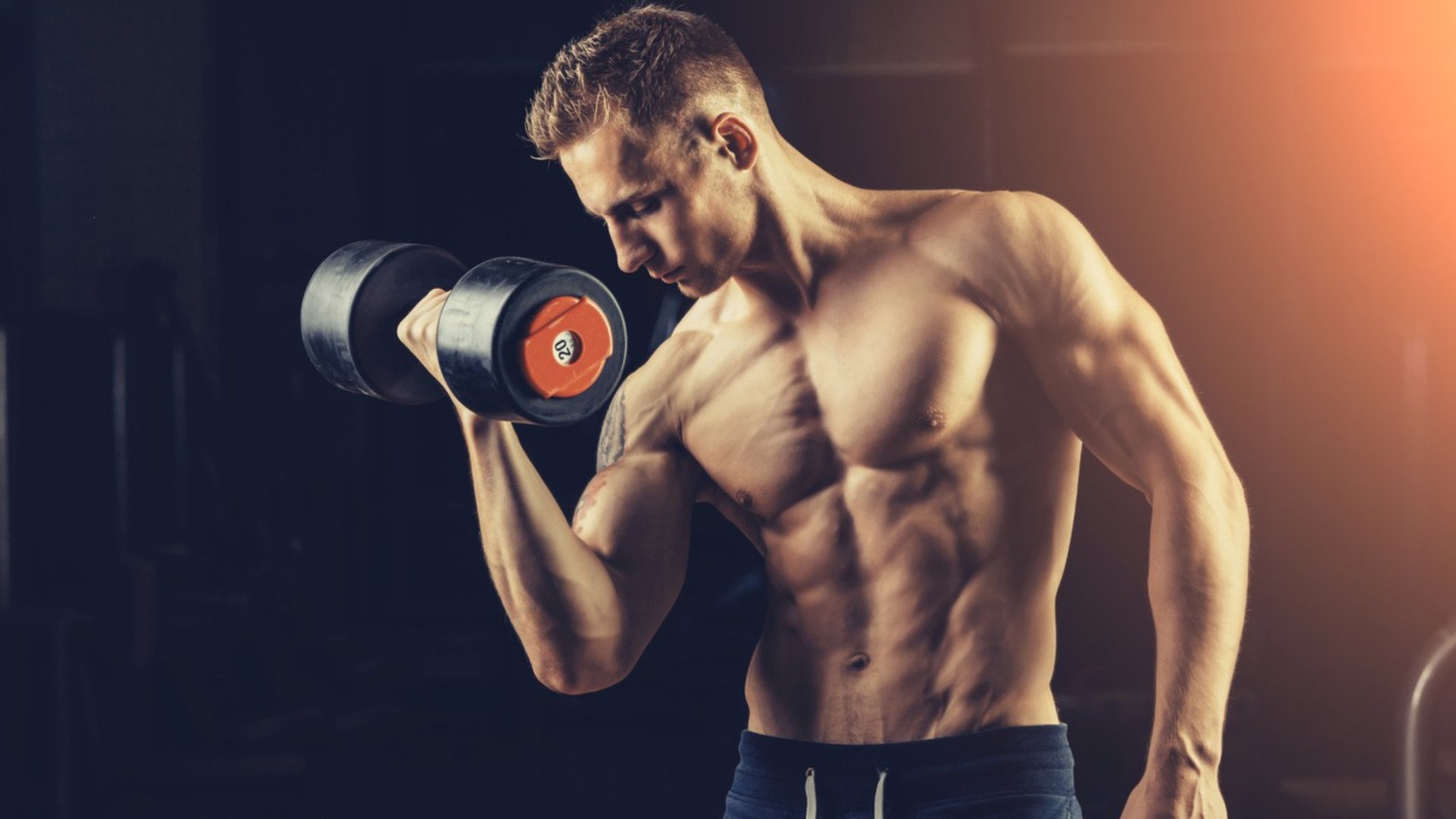
- Biceps Brachii Muscle (Anatomy)
- 15 Best Biceps Exercises With Dumbbells
- 1. Standing Dumbbell Curls
- 2. Dumbbell Reverse Curl
- 3. Incline Dumbbell Curl
- 4. One Arm Dumbbell Preacher Curl
- 5. Zottman Curl
- 6. Standing Dumbbell Drag Curl
- 7. Concentration Curl
- 8. Dumbbell Hammer Curl
- 9. Dumbbell Reverse-Grip Concentration Curl
- 10. Cross-Body Hammer Curl
- 11. Dumbbell Reverse Preacher Curl
- 12. Standing Wall Curl
- 13. Dumbbell Hammer Preacher Curl
- 14. Standing Dumbbell Preacher Curl
- 15. Alternating Seated Dumbbell Curl
- How To Build Bigger Biceps with Dumbbell
- Dumbbell Bicep Exercises Training Tips
- 1. Optimize For Bicep Workout Volume
- 2. Train As Per Your Goal
- 3. Focus On Proper Form
- 4. Add Variations In your Bicep Workout Routine
- 5. Progressive Overload To Grow Bicep
- 6. Add Compound Exercises
- 7. Don’t neglect other muscle groups
- Dumbbell Bicep Workout Plan For Beginner
- Workout Routine For Beginner
- Workout Routine For Intermediate
- Conclusion
Biceps Brachii Muscle (Anatomy)
The biceps brachii muscle (biceps) is a large, thick upper arm muscle.
The Biceps Brachii is attached to the forearm bone called the radius and originates at the scapula in two heads (the bicep gets its name from the two heads).
Your biceps brachii has two heads: short (inner) and long (outer).
- The short head is located along the inner side of the anterior upper arm and the long head is located along the outer side of the anterior upper arm.
- The long head comprises most of the biceps’ peak, whereas the short head sits on the inner side and contributes to the width of the biceps.
The biceps comprises four muscles alongside the brachialis, brachioradialis, and coracobrachialis muscles comprising the upper arm.
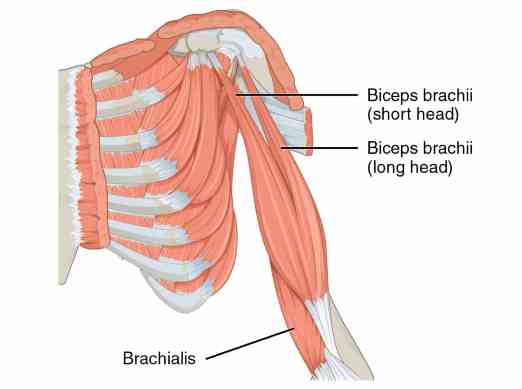
Want to take your gains to the next level? Discover your daily calorie needs with our free TDEE calculator
15 Best Biceps Exercises With Dumbbells
Since these exercises are dumbbell-only, you can easily integrate them into an existing program or perform them separately if you do your biceps workout at home with dumbbells.
Here are 15 Best Biceps Exercises With Dumbbells that help to build stunning biceps.
1. Standing Dumbbell Curls
The biceps curl is a well-known weight-training exercise that works the muscles of the upper arm and, to a lesser extent, those of the lower arm.
This move is popular among gym goers of all experience levels and can be done standing or sitting.
It works the biceps muscles at the front of the upper arm and the lower arm’s muscles, brachialis and brachioradialis.
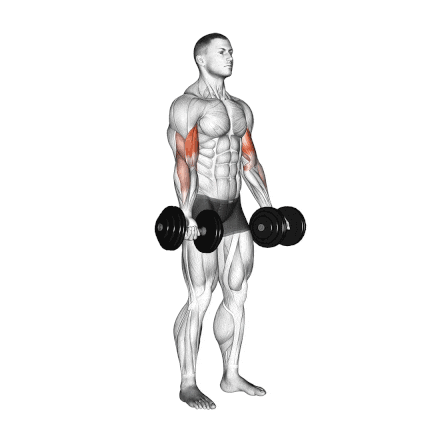
How To Do
- Stand up straight and keep your feet shoulder-width apart.
- Hold a set of dumbbells by your side.
- The dumbbells should not be touching your body.
- Your palms should be facing upward.
- Bend the elbows slightly to take up the slack. Tension should be on the biceps.
- Slowly curl the dumbbells up as far as possible.
- Then, slowly lower the dumbbells back down to the starting position.
Tips
- Do not swing the body back as you curl up the weight.
- Do not let the dumbbells touch your body.
2. Dumbbell Reverse Curl
Reverse bicep curls can be your secret weapon in your quest to build bigger arms.
The dumbbell reverse curl is a variation of the standard dumbbell biceps curl. In which you hold the dumbbells with your palms facing down (overhead grip).
It is great for building both your bicep and brachialis (upper arms), and also stimulates your brachioradialis (lower arm) muscle.
This exercise is also used to strengthen the forearms and improve grip strength.
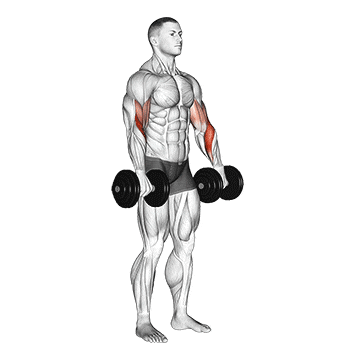
How To Do
- Stand straight, keeping your feet shoulder-width apart.
- Grab a dumbbell in each hand using an overhand grip, and arms should be fully extended.
- Keep your upper arms stationary and your back straight
- Lift the dumbbell up towards your shoulders and breathe out slowly as you do it.
- Continue curling the dumbbells until they are at shoulder level.
- Return to the starting position in a smooth arc, and inhale as you do so.
Tips
- Ensure your elbows stay close to your sides; they should not move forward or outward.
- Don’t let your shoulders shrug up towards your ears.
- Using a slow eccentric exercise can help improve tension and mind-muscle connection.
Read More: Reverse Bicep Curl: Muscle Worked, Benefits, Variations
3. Incline Dumbbell Curl
The incline dumbbell curl is a variation of the bicep curl exercise, which is performed on an inclined bench. It is one of the best exercises to train the bicep and brachialis muscles.
One of the primary benefits of the incline dumbbell curl is the increased stretch and range of motion it provides to the long head of your bicep.
The researchers found that the incline dumbbell curl produced the highest EMG activity in the long head of the biceps, followed by the preacher curl and the concentration curl. It also produced the highest EMG activity in the brachialis.
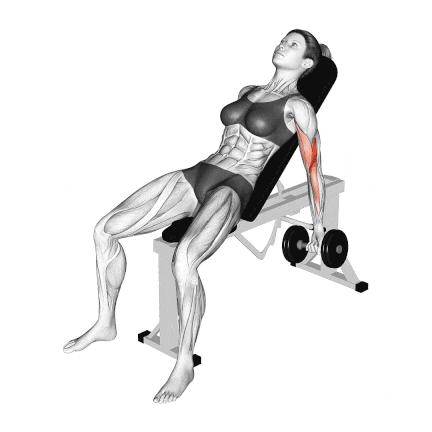
How To Do
- Set an incline bench at a 45-degree angle and sit with your back firmly against the bench.
- Grab a pair of dumbbells with a supinated grip (palms facing up) and let them hang at arm’s length by your sides.
- Slowly curl the dumbbells up to shoulder levels.
- At the top of the movement, contract the bicep muscles and pause briefly to squeeze the muscle.
- Slowly lower the dumbbells back to the starting position.
Tips
- It is better to start with a lighter weight and gradually increase as you get stronger.
- Keep your back flat against the bench throughout the exercise to maintain proper form.
- Go full range to build longer biceps.
4. One Arm Dumbbell Preacher Curl
Dumbbell Preacher Curl are a remarkable exercise for building the short head of biceps because they produce an intense muscle contraction on every single rep.
The one-arm dumbbell preacher curl is a variation of the preacher curl exercises, uses dumbbells and single arm movements for better control and targeting of the bicep muscles.
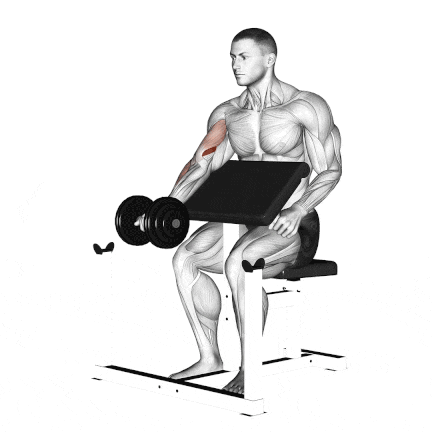
How To Do
- Adjust the preacher bench seat so that your arm is level with the top of the bench.
- Grab a dumbbell on one arm with an underhand (palms up) grip and rest your arm against the bench with your arm extended fully down.
- Slowly curl the dumbbell up towards your shoulder.
- Keep your arm on the bench at all times until you reach the top position.
- Hold for a count, squeeze and isolate your bicep.
- Repeat the desired number of repetitions, then change to your other arm.
Tips
- Perform this exercise in a slow, controlled manner for best results.
- As a general rule, always hit the weakest arm first. In most cases, this is the left arm.
5. Zottman Curl
The dumbbell zottman curl is one of the most effective variations of the bicep curl.
It utilizes different hand positioning at different portions of the lift.
- The first portion, the regular curl, focuses on bicep strength.
- The second lowering portion, the dumbbell reverse curl, allows you to overload the forearms.
You can perform Zottman curls with both arms at the same time, or alternate the arm you lift with.
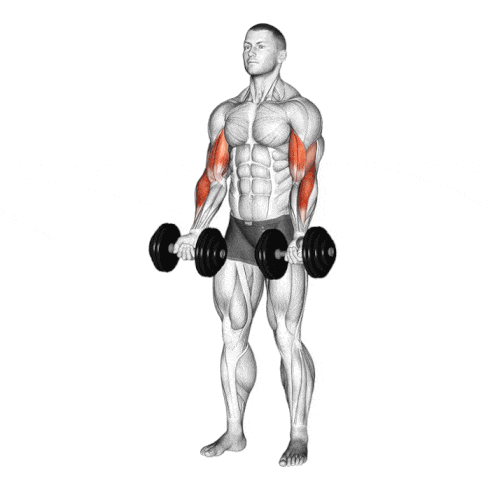
How To Do
- Hold a pair of dumbbells to your sides.
- Keep your palms facing up as you curl the weights up to your shoulders. Pause at the top of the movement.
- Slowly rotate your grip so your palms are facing downwards.
- Lower the dumbbells slowly back to the starting position using an overhand grip.
- When the dumbbells are close to your thighs, again turn your hands while returning to the starting position.
Tips
- Perform this exercise in a slow, controlled manner for best results.
- Don’t go heavy. Choose a lighter weight and focus on perfecting your form.
6. Standing Dumbbell Drag Curl
While less popular than the standard dumbbell bicep curl, the dumbbell drag curl is an extremely effective bicep exercise.
The dumbbell drag curl is a unique bicep curl variation in which you don’t completely bring the weight in front of your body, which makes it more difficult to swing and use momentum to get the weight up.
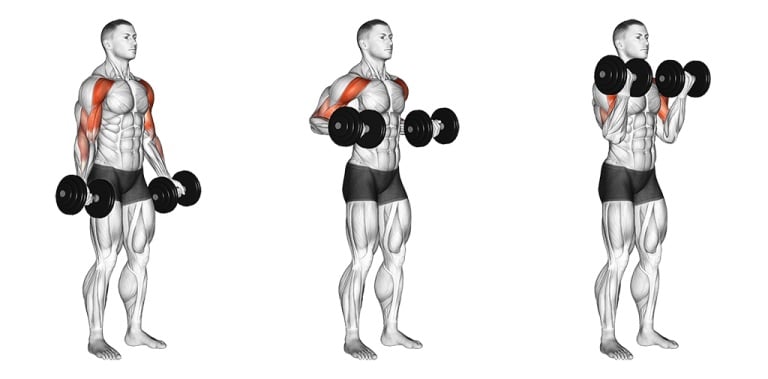
How To Do
- Stand with your feet shoulder-width apart, your knees slightly bent and your abs are drawn in.
- Grab the dumbbell with a double underhand (supinated) grip, with your hands slightly wider than shoulder-width apart.
- Bring your elbows and shoulders back slightly as you curl the Dumbbells upwards.
- It should feel like you are “dragging” the dumbbell up to your body.
- Squeeze your biceps hard at the top and slowly return to the starting position.
Tips
- Try to use a lighter to moderate weight
- Perform this exercise in a slow, controlled manner for best results.
- Keep your elbow back to keep the stress on your biceps.
7. Concentration Curl
The Concentration Curl is the best exercise to build a biceps peak. It’s not the same as doing a few quick reps of curling in front of the mirror.
Instead of rushing to the finish line and racking up the volume, your goal is to isolate the biceps, putting yourself in a position to prevent cheating or bodybuilding.
Resting the upper arm against the thigh prevents movement at the shoulder and is an excellent way to isolate the biceps.
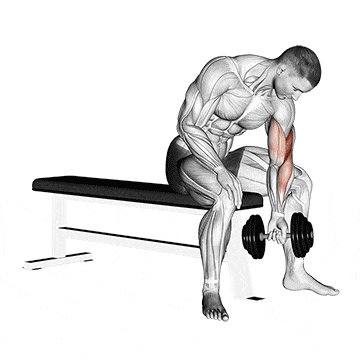
How To Do
- Sit on a bench, with a dumbbell between your legs.
- Grab the dumbbell with one hand, then place your upper arm (your triceps muscle) against your thigh.
- Bend down at your torso, and rest your other arm on your knee.
- Lift the weight up with control and keep your wrist in a neutral position. Emphasize the squeeze at the top of the rep.
- Slowly curl the dumbbell back to the start position.
- Perform 3 sets of 8 to 12 reps per arm
Tips
- To make your posture stronger, tighten your core and engage your shoulders.
- Don’t lean backwards or move your shoulders. Keep your attention on your biceps.
8. Dumbbell Hammer Curl
While traditional bicep curls are popular, hammer curls offer a fresh twist and offer a range of unique benefits. It is one of the most popular exercises among bodybuilders and regular weightlifters.
The hammer curl very similar to the biceps curl, with the only difference being the neutral (hammer) hand position.
It is one of the best exercises that you can do to build your forearm and bicep muscles. It is an effective isolation workout that targets the brachialis and brachioradialis.
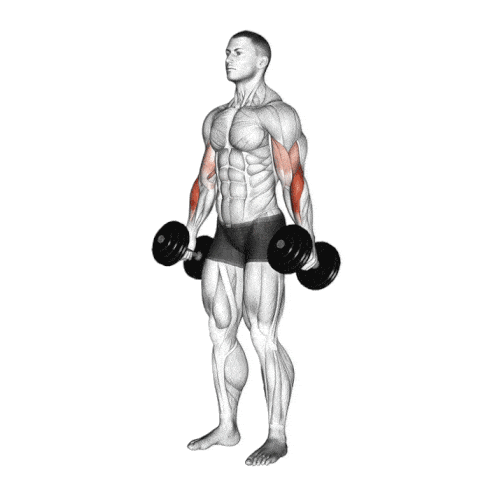
How To Do
- Stand with your feet shoulder-width apart and a slight bend in your knees.
- Hold a pair of dumbbells in your hands with your palms facing towards your body.
- Keep your elbows close to your body and slowly curl the dumbbell up to your shoulders.
- Pause at the top of the lift for a second, squeeze your biceps,
- Then lower the weights under control.
Tips
- Raise and lower the dumbbell slowly.
- Keep in control of using your strength, not using momentum or gravity.
- Neither lean back as you lift the weight nor lean forward as you lower it.
Read More: Cable Hammer Curl: Muscle Worked, Benefit & Alternate
9. Dumbbell Reverse-Grip Concentration Curl
The reverse grip dumbbell concentration curl is a great move. When done correctly, it can effectively target your bicep and forearms.
It is an isolation exercise that targets the biceps brachii and brachioradialis muscles.
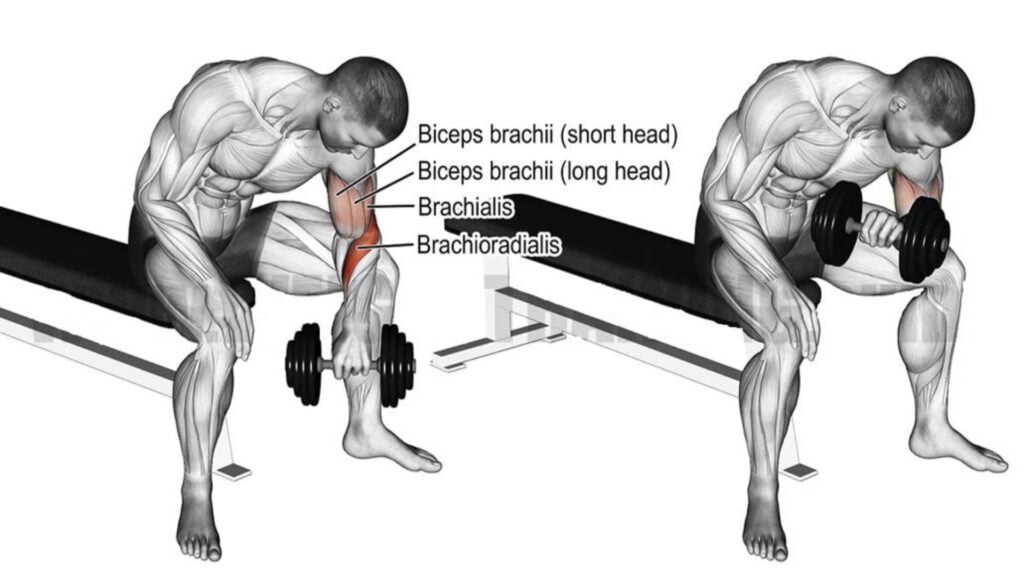
How To Do
- Sit on a bench with your legs apart, grab a dumbbell in one hand (say left hand).
- With your left arm almost fully extended, rest your elbow against the inside of your left thigh.
- Pronate your wrist so that your palm faces backward.
- Exhale as you curl the dumbbell up towards your shoulder. Hold and squeeze your biceps for a count of two.
- Inhale as you slowly lower the dumbbell to the starting position.
- Repeat with your right arm.
Tips
- Don’t lockout at the bottom of the exercise.
- Keep your back straight and your upper arm still.
10. Cross-Body Hammer Curl
Are you looking for an exercise to strengthen your forearm and bicep, then the cross-body hammer curl is the best option for you.
The cross-body hammer curls are a powerful variation of the traditional hammer curl, specifically designed to target the brachialis and brachioradialis muscles.
Rather than lifting the weights directly in front of the body, you lift them across the torso.
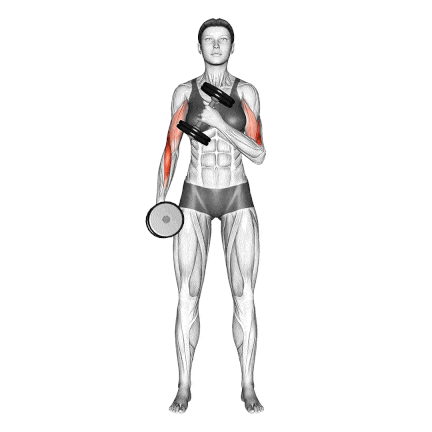
How To Do
- Stand with your feet shoulder-width apart and a slight bend in your knees.
- Hold a pair of dumbbells in your hands with your palms facing towards your body.
- Keep your elbows close to your body and slowly lift the left dumbbell up, across your body, and towards your left shoulder.
- Pause for a second at the top of the lift, squeeze your biceps, then lower the weights under control.
- Repeat with your right arm and continuously do alternating arms.
Tips
- Raise and lower the dumbbell slowly.
- Neither lean back as you lift the weight nor lean forward as you lower it.
11. Dumbbell Reverse Preacher Curl
The reverse preacher curl is a variation of the standard preacher curl that targets the brachialis more, which lies deeper than your biceps brachii in the upper arm.
The reverse bicep preacher curl may be performed with a barbell, dumbbells, or EZ-curl bar.
However, the dumbbell reverse curl provides better stability and the full range of motion.
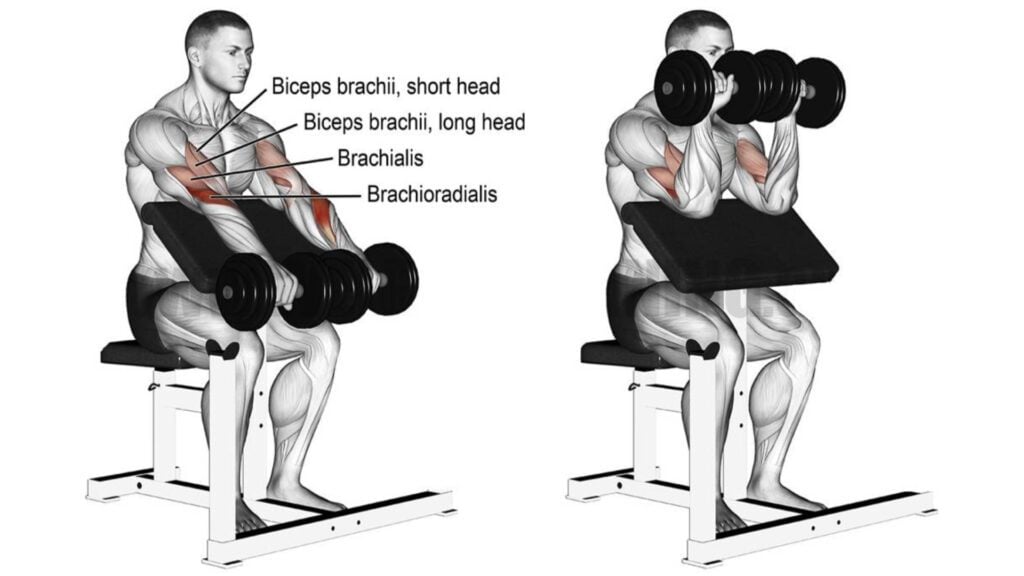
How To Do
- Adjust the preacher bench seat so that your arms are level with the top of the bench.
- Grab a dumbbell in each hand with a pronated (palms down) grip and rest your arm against the bench with your arm extended fully down.
- Keep your arms on the bench as you curl the dumbbells up towards your head until you reach the top position.
- Hold for a count, squeeze and isolate your biceps.
Tips
- Do not lock out your elbows at the bottom of the reverse curl.
- Try to use a lighter to moderate weight.
12. Standing Wall Curl
The Standing wall curl is the best variation of the standing dumbbell curl because this exercise is done with strict form.
To perform cheat-free wall curls, you’ll need an open wall and a set of dumbbells.
Grab a weight that’s lighter than you used to perform a standard curl.
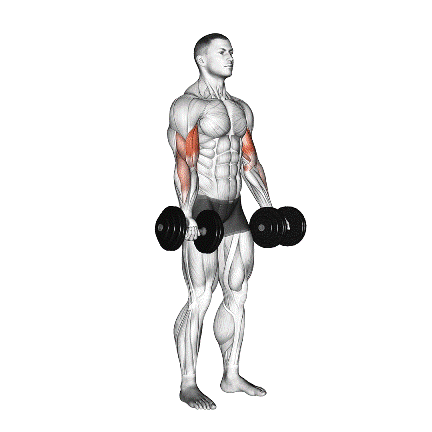
How To Do
- Stand with your back to a wall and your feet shoulder-width apart.
- Hold your arms down by your sides with your palms facing in.
- Curl the dumbbells upwards, rotating your wrists so that your palms face up.
- Make sure your elbows don’t move forward. Pause at the top of the move
- Slowly lower the dumbbell to the starting position.
Tips
- Perform this exercise in a slow, controlled manner for best results.
- Try to use a lighter to moderate weight.
13. Dumbbell Hammer Preacher Curl
This is a great variation of the preacher’s curl, and you should add it to your arsenal of dumbbell biceps exercises.
It is a very effective exercise that targets the brachioradialis, brachialis, and bicep muscles.
Using a hammer/neutral grip targets more of the brachioradialis and brachialis than the biceps.
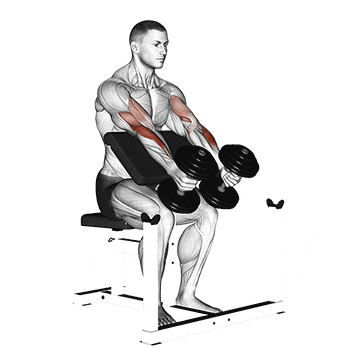
How To Do
- Adjust the preacher bench seat so that your arms are level with the top of the bench.
- Grab a dumbbell in each hand with a neutral/hammer grip and rest your arm against the bench with your arm extended fully down.
- Keep your arms on the bench as you slowly curl the dumbbells towards your shoulder.
- Hold for a count, squeeze and isolate your biceps.
- Do 8-12 and 3–4 sets
Tips
- Perform this exercise in a slow, controlled manner for best results.
- Do not lock out your elbows to prevent a bicep tear.
14. Standing Dumbbell Preacher Curl
The standing dumbbell preacher curl is an alternative to the seated dumbbell preacher curl.
There are some notable differences, like the benches and weights which are used.
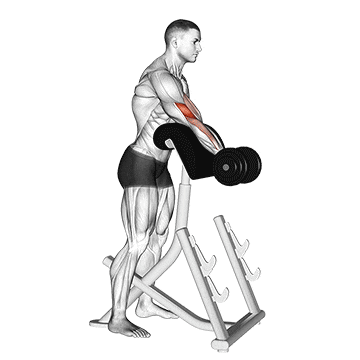
How To Do
- Adjust the bench to an incline level so that you can comfortably rest your arm down the back of the headrest.
- Grab a dumbbell in one arm and extend it over the bench so that your forearm and tricep are rested upon the bench.
- Hold on to the top of the bench with the opposite arm to stabilize your body and to balance the weight.
- Slowly curl the dumbbell up towards your shoulder, isolate the bicep and squeeze your muscle.
Tips
- Make sure to keep your upper arms flat on the bench during the exercise to eliminate cheating.
- Perform this exercise slowly and with control.
Read More: Preacher Curl: How To Do It Correctly And Best Variation
15. Alternating Seated Dumbbell Curl
The seated bicep curl is an excellent exercise, as it allows you to contract the biceps more and build muscle.
In dumbbell curls, the biceps’ natural full range of motion is enhanced. Therefore, it provides a better bicep contraction.
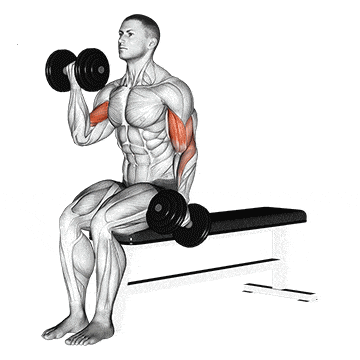
How To Do
- Sit on a bench or chair with a straight back.
- Hold a dumbbell in each hand, palms facing forward, and let your arms hang by your sides.
- To begin, lift one dumbbell up towards your shoulder.
- Lower the dumbbell back down in a controlled manner while simultaneously starting to lift the opposite arm.
Tips
- Keep a controlled motion and avoid jerky movements.
- Exhale as you lift the dumbbell. Inhale as you lower the dumbbell.
- Bending forward and leaning forward cuts the range of motion.
How To Build Bigger Biceps with Dumbbell
If you want full development of your biceps, you need to stress them with adequate tension through their entire range of motion, so you get maximum eccentric contraction (stretching tension) and concentric contraction (contraction tension).
It’s a good idea to add various exercises to your bicep workout routine to target the muscle from different angles and provide overall muscle growth.
Be smart: don’t limit yourself to dumbbell bicep exercises. Get the benefits they offer and use other bicep exercises to supplement them when needed.
- Barbell Bicep Exercises & Workout For Mass & Strength
- Bicep Cable Workout To Build Mass And Strength
- Bodyweight Biceps Exercises At Home To Bigger Arm
A bicep dumbbell workout can be easily incorporated into any training program and can be particularly effective when used alongside, barbells, machines, and cables to build the biggest, strongest bicep possible.
Dumbbell Bicep Exercises Training Tips
Here are some tips for effective dumbbell bicep training:
1. Optimize For Bicep Workout Volume
Of course, the number of sets and reps will be determined based on your fitness journey, but here is a great starting point:
| Level | Sets per Week | Rep Ranges and Loads |
|---|---|---|
| Beginners | ~10 sets | 6–8 reps with heavy load |
| Intermediate | ~15 sets | 8–15 reps with moderate load |
| Advanced | ~20 sets | 15-20+ with light load |
Note: When progress stalls, consider adding sets to increase volume. The load should bring you to or near failure within the specified rep ranges for effectiveness.
2. Train As Per Your Goal
- For muscle endurance: Aim for 3–4 sets of 12–15 reps, with a moderate amount of resistance.
- For muscle strength: Aim for 3–5 sets of 6–10 reps, with a heavier amount of resistance.
- For muscle hypertrophy (increased muscle size): Aim for 3–4 sets of 8–12 reps, with a moderate to heavy amount of resistance.
It is always best to start with a lower number of reps and sets, and then gradually increase as your strength improves.
Furthermore, it is important to allow for adequate rest between sets, typically 60–90 seconds.
3. Focus On Proper Form
Maintaining proper form during bicep exercises with dumbbells is crucial for preventing injury and maximizing results.
Pay close attention to your technique and avoid swinging or using momentum to lift the weight.
4. Add Variations In your Bicep Workout Routine
It is important to vary your bicep exercises with dumbbells to target different muscle fibers and prevent plateauing.
Incorporate a range of exercises that target different areas of the biceps, such as curls, hammer curls, and preacher curls.
5. Progressive Overload To Grow Bicep
To build bigger biceps, it’s important to continually increase the weight you’re using.
Gradually increase the resistance over time to keep your muscles challenged and growing.
6. Add Compound Exercises
It’s best to perform them after compound exercises such as chin-ups and row variations.
These compound exercises use the most weight and exhaust the biceps, making it easier to fully target them with isolation moves.
7. Don’t neglect other muscle groups
Bicep exercises should be part of a comprehensive arm workout that includes exercises for the triceps, and forearms.
Neglecting these muscle groups can result in imbalances and limit your overall results.
Dumbbell Bicep Workout Plan For Beginner
Here is a beginner-friendly dumbbell bicep workout routine that can be done at the anywhere:
Workout Routine For Beginner
| Exercise | Sets | Repetitions |
|---|---|---|
| Dumbbell Bicep Curl | 3-4 | 8-10 |
| Hammer Curl | 3-4 | 8 |
| Dumbbell Reverse Curl | 4 | 8-10 |
Workout Routine For Intermediate
| Exercise | Sets | Repetitions |
|---|---|---|
| Seated Dumbbell Curl | 4 | 8-10 |
| Cross-Body Hammer Curl | 3-4 | 10-12 |
| Dumbbell Concentration Curl | 4 | 10-12 |
| Dumbbell Preacher Curl | 3 | 8-10 |
Conclusion
For anyone interested in strengthening their biceps and gaining muscle, this dumbbell exercise is highly recommended.
Furthermore, it not only allows for targeted muscle development, but also provides strength. It is easy to do and requires no more scientific details. If done consistently, the results will speak by themselves.
Thanks for reading, enjoy working your Biceps!
Stay Fit, Live a Happy and Healthy Life
References
- Marcolin G, Panizzolo FA, Petrone N, Moro T, Grigoletto D, Piccolo D, Paoli A. Differences in electromyographic activity of biceps brachii and brachioradialis while performing three variants of curl. PeerJ. 2018 Jul 13;6:e5165. doi: 10.7717/peerj.5165. PMID: 30013836; PMCID: PMC6047503.
- Naito A. Electrophysiological studies of muscles in the human upper limb: the biceps brachii. Anat Sci Int. 2004 Mar;79(1):11-20. doi: 10.1111/j.1447-073x.2004.00064.x. PMID: 15088788.
- Nakazawa K, Kawakami Y, Fukunaga T, Yano H, Miyashita M. Differences in activation patterns in elbow flexor muscles during isometric, concentric and eccentric contractions. Eur J Appl Physiol Occup Physiol. 1993;66(3):214-20. doi: 10.1007/BF00235096. PMID: 8477676.
- Oliveira LF, Matta TT, Alves DS, Garcia MAC, Vieira TMM. Effect of the shoulder position on the biceps brachii EMG in different dumbbell curls. Journal of Sports Science & Medicine. https://pubmed.ncbi.nlm.nih.gov/24150552/
- Melrose, Don PhD, CSCS*D. Exercise Technique: The Zottman Curl. Strength and Conditioning Journal 36(1):p 92-93, February 2014. | DOI: 10.1519/SSC.0b013e318297a092

Manish is a NASM-certified fitness and nutrition coach with over 10 years of experience in weight lifting and fat loss fitness coaching. He specializes in gym-based training and has a lot of knowledge about exercise, lifting technique, biomechanics, and more.
Through “Fit Life Regime,” he generously shares the insights he’s gained over a decade in the field. His goal is to equip others with the knowledge to start their own fitness journey.
